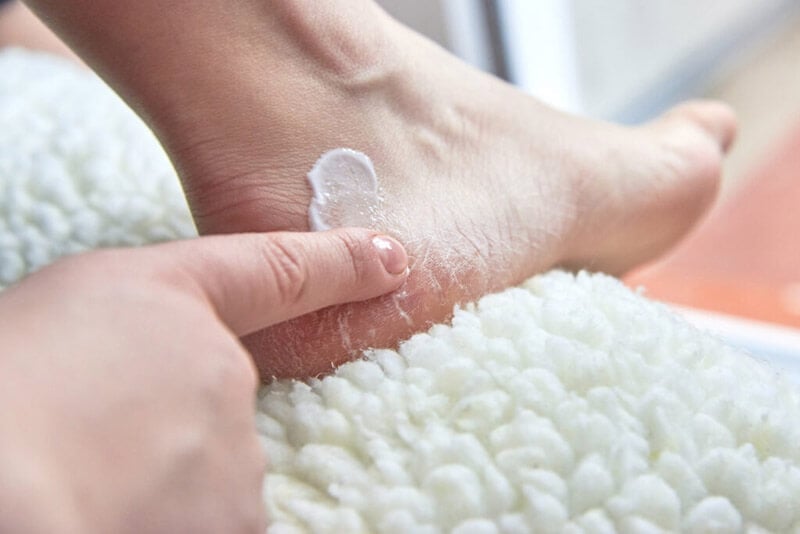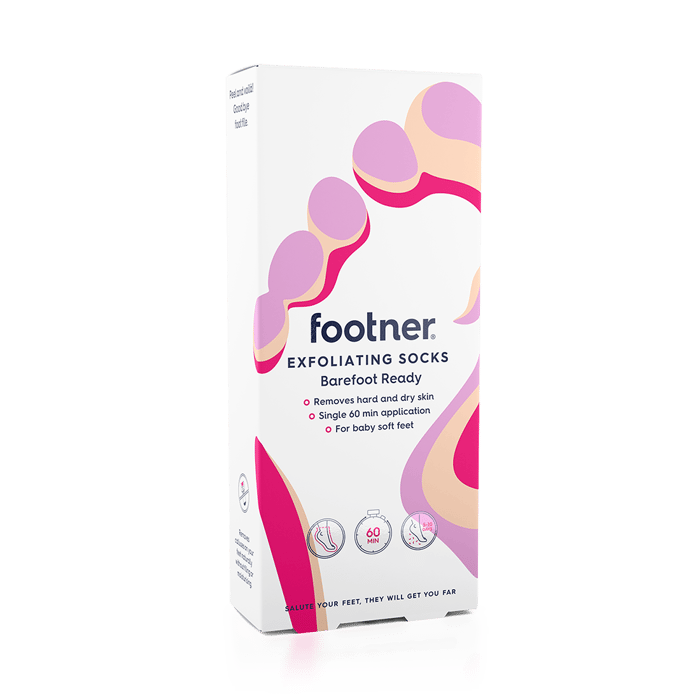Cracked Feet & Heels
Having dry and cracked feet & heels is a common concern. Although not usually serious, the condition can cause pain and discomfort in addition to having an unpleasant appearance like scaly feet. Also known as heel fissures, cracked heels are generally a result of dry skin on feet or extra pressure on the heel, which in turn causes the skin to thicken and crack.
There are many different possible factors that can contribute to cracked skin on feet. However, there are also plenty of home remedies and treatments available for repairing cracked heels.
This article introduces some of the most common causes of cracked feet & heels, as well as the symptoms to watch out for. It also covers several effective methods for removing dry skin from feet and treating or preventing cracked heels.
Symptoms of cracked feet & heels
The main symptom of having heel fissures is, of course, cracks in the skin of your heels. It’s most common to have deep cracks in heels, but you may also notice cracked skin between toes or on other parts of your foot. In addition, there can be accompanying symptoms such as:
- Yellow or brown discolouration of the skin
- Itching
- Redness
- Pain
- Bleeding
- Ulceration
- Flaky skin
- Heel peeling
- Toe splitting
- Loss of feeling in the affected area
In severe cases, heel fissures may become infected. Symptoms of this include swelling, pain, redness, and warmth.

Causes of cracked feet & heels
The most common underlying cause of cracked feet & heels is the development of thick dead skin on feet. When you stand up, walk or run, it puts pressure on your feet and causes the pad of your heel to expand sideways. If the skin is dry, it will be stiffer and less elastic. This, in turn, can result in cracking.
There are many different factors that can contribute to the development of dry and dead skin on feet. Some of the most frequently-seen causes are listed below.
Lifestyle factors that contribute to cracked feet & heels
There are certain actions and lifestyle habits that can increase the likelihood of developing dry ankle skin, cracks in between toes, and painful cracked heels. These include:
- Standing up for long periods of time
- Walking around outside barefoot
- Wearing sandals or other shoes that are open at the heel
- Wearing shoes that don’t fit you properly, rub your feet, or don’t offer enough support
- Taking long, hot showers or baths
- Using harsh soaps that strip your skin of its natural oils
- Being overweight, as this puts more pressure on your feet
- Having a poor gait when walking
- Eating a poor diet, which leads to vitamin deficiencies
- Not drinking enough water, which can cause dehydration
- Not moisturising your feet
Environmental factors that contribute to cracked feet & heels
The environment you’re in can also raise the risk of developing dry skin on toes and feet. For example:
- Cold weather and dry air
- Low humidity
- Your feet getting hot in your shoes
Medical factors that contribute to cracked feet & heels
In addition to external factors, certain medical conditions you suffer from can raise the risk of dry skin on feet. These include:
- Obesity
- Diabetes
- Skin conditions such as eczema
- Psoriasis
- Fungal infections such as athlete’s foot
- Pregnancy
- Ageing
- Hypothyroidism
Remedies for cracked feet & heels
In most cases, you will be able to relieve the symptoms of cracked feet & heels through at-home remedies. These range from special healing cream for cracked heels to lifestyle changes. Some of the most effective methods are:
- Use Footner exfoliating socks for removing dead skin from the foot
- Using heel balms to moisturise your feet
- Soaking your feet in warm water to soften the thick dead skin on the feet, then using a pumice stone or similar to gently remove it
- Wearing socks after moisturising your feet or using cracked heel cream to keep the product in place (and your floor clean)
These methods can work not only on cracked heels but also for split skin under the toe or a painful crack on the ball of your foot. If you have any other skin conditions on your feet, it’s a good idea to tackle those too. For example, if you suffer from blisters then use heel blister treatment to clear them up.
Medical treatment for cracked feet & heels
In severe cases of cracked feet & heels, it may be necessary to seek medical treatment from a doctor or podiatrist. For instance, if you have very painful cracked heels, your heel fissures are bleeding, or you think you have an infection, then book an appointment rather than try to solve the problem yourself.
Similarly, if you have an underlying health condition (such as diabetes) that you think is causing your cracked feet & heels, speak to your GP about the best treatment options.
Possible methods include:
- Prescription medication such as painkillers or skin softeners
- Stronger medicated healing cream for cracked heels
- Treatments for underlying health conditions such as athlete’s foot or heel blister care
- Using medical glue to seal heel fissures
- Antibiotics if you have an infection
- Strapping up cracked heels with bandages or other dressings
- Special shoe inserts or heel pads
How to prevent cracked feet & heels
Prevention is often the best form of treatment, and there are plenty of steps you can take to help you avoid developing cracked feet & heels. For instance:
- Keep your feet clean and dry
- Moisturise your feet twice a day to prevent dry ankle skin and dry skin on the toes
- Use gentle soaps and other cleansing products on your feet
- Use Footner exfoliating socks regularly to remove dead skin on feet before it builds up and results in cracked heels
- Try not to spend too long in the bath or shower
- Avoid using very hot water in the bath or shower
- Check your feet frequently to spot problems before they become serious
- Wear shoes with closed heels to provide more support
- Wear shoes that are cushioned and fit you well
- Wear padded cotton socks that wick away moisture and allow your skin to breathe
- Try to avoid wearing shoes with a tall, thin heel, as this can make your heel expand sideways and increase the risk of cracking
- Try not to stand up in one position for prolonged periods of time
- Eat a healthy diet and drink 6 to 8 glasses of water a day to maintain good levels of hydration
Cracked Feet & Heels FAQs
What causes dry, cracked feet?
The most common cause of cracked feet is having dry, thick dead skin on the feet. This reduces the elasticity of your skin and makes it more prone to cracking. Dry skin on the feet is often the result of factors such as poorly-fitted or inappropriate footwear, cold and dry weather, not moisturising your feet, and bathing in water that’s too hot.
How do you treat cracked feet?
In most instances, you can treat cracked feet by yourself at home. You can do this by using products such as heel balms to moisturise dry skin on the feet and Footner exfoliating socks to soften and remove hard skin.
How do you heal cracked feet naturally?
A great way to heal cracked feet naturally is to make lifestyle changes such as wearing cushioned shoes that fit well and padded cotton socks and not standing up in one position for too long.
How do you heal cracked feet overnight?
Unfortunately, you may not be able to heal cracked feet overnight. However, you should notice an improvement in a week or two if you make lifestyle changes, treat your feet using Footner exfoliating socks, and moisturise.
When should you see a doctor about cracked feet & heels?
Although rarely serious, in certain cases, it may be necessary to seek medical treatment for cracked feet & heels. For example, if you are suffering from bleeding or very painful cracked heels, think that your heel fissures have become infected, or notice no improvement after a couple of weeks of home remedies, then it’s wise to book an appointment. Similarly, if you have an underlying health condition such as diabetes that may be contributing to your cracked feet & heels, then you should get medical advice rather than attempt to treat them yourself.


